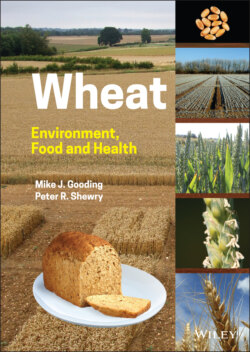Читать книгу Wheat - Peter R. Shewry - Страница 35
1.4.4 The Fall and Rise of Whole Grain Foods
ОглавлениеThe adoption of roller milling made white flour available to all the population. This led to massive changes in the diet of working people with coarse wholemeal or brown breads being almost completely replaced by white products in the UK by 1880 CE. Although the science of nutrition was then in its infancy, concerns were nevertheless expressed about the impact of this change in diet on the health of the population.
An early supporter of wholemeal bread was Sylvester Graham (1794–1851), an American Presbyterian minister, who proposed a lifestyle that combined temperance, vegetarianism, and the consumption of whole‐grain bread. His views were expounded in his preaching and in publications, notably Lectures on the Science of Human Life, published in 1849. They led to a movement referred to as Grahamism and inspired the development and marketing of Graham flour, Graham bread, and Graham crackers. The last of these are still widely consumed in the USA. However, Graham did not endorse any products or benefit financially from their sale.
Foremost among the critics of white bread in the UK were May Yates (née Mary Corkling) (1850–1938) and Thomas Allinson (1858–1918). Allinson qualified as a doctor in 1879 and established a practice in London. He believed that diet was crucial for health, and particularly advocated the consumption of stone ground wholemeal wheat. He was frequently in dispute with conventional medicine and was struck off (disqualified from practicing) in 1892, having been found guilty of infamous conduct (self‐promotion). In the same year he purchased a stone mill and established a milling and baking company that continues to produce wholemeal bread to the present day. By contrast, May Yates was not trained as a scientist but became convinced of the benefits of wholemeal bread during a visit to Sicily. She founded the Bread Reform League in 1880 and spent 40 years campaigning for the use of high extraction (about 85%) flours. The late nineteenth century also saw the introduction of improved patent breads. The most well‐known of these, and the only one still produced today in the UK, is Hovis, which is enriched in wheat germ.
Despite the compulsory production of high extraction and wholemeal breads in the UK during the two World Wars, white bread remained the favourite for much of the British population, and in many other countries. It is not difficult to understand why this is the case; factory‐produced white bread stores well (with a shelf life of up to a week), while its mild flavour and soft texture means that it has high consumer acceptability and combines well with other foods. By contrast, wholemeal products are more expensive, strongly flavoured, may have a coarse texture, and store less well.
Nevertheless, it is now recognized that the bran fractions are rich in fibre, minerals, vitamins, and phytochemicals and, therefore, that white flour is depleted in beneficial components compared to whole grain (e.g. Wang et al. 2013). As its health benefits have been promoted, the consumption of wholemeal has increased in some countries over the last decade. The catalyst for this increase was the approval in 1999 by the US Food and Drug Administration (FDA) of an application to ‘use the following claim on the label and in labelling of any product that meets the eligibility criteria described in the notification: Diets rich in whole grain foods and other plant foods and low in total fat, saturated fat, and cholesterol, may help reduce the risk of heart disease and certain cancers’ (USFDA 1999). The FDA further defined whole grain foods as containing 51% or more whole grain ingredient(s) by weight, meaning that the amount of fibre required to qualify could be below 6% (based on whole grain containing 11% fibre). This was followed by the approval of several health claims for whole grain fibre by the European Food Safety Authority (EU 2006, 2012) (see Chapter 9). These approvals have provided an economic stimulus to the production and marketing of wholegrain products.
The marketing of wholegrain products has, however, been confusing for the consumer because of the use of different definitions. Although the FDA minimum of 51% is clearly not equivalent to the whole grain, the omission of only a small proportion of the bran fraction can have a significant impact on palatability and consumer acceptability without seriously compromising the health benefits. The consortium of the HEALTHGRAIN EU project therefore launched a series of discussion meetings that resulted in an agreed definition (van der Kamp et al. 2014), which should facilitate the development and acceptance of whole grain products in the future. This states that:
1 Whole grains shall consist of the intact, ground, cracked, or flaked kernel after the removal of inedible parts such as the hull and husk. The principal anatomical components – the starchy endosperm, germ and bran – are present in the same relative proportions as they exist in the intact kernel.
2 Small losses of components, that is, less than 2% of the grain (< 10% of the bran), that occur through processing methods consistent with safety and quality are allowed.
